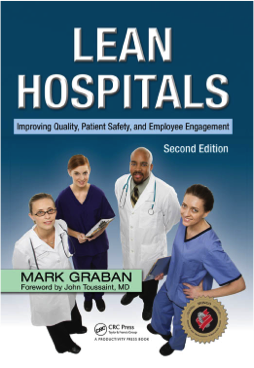
Today's post is an update on the 2nd revised edition of my first book, Lean Hospitals: Improving Quality, Patient Safety, and Employee Engagement. The final edits and fully typeset book have been sent to the printer and Amazon currently shows no date – but it should be available by December 1, if not earlier, based on my understanding of the process. There will also be a Kindle version available at that time or soon thereafter.
You can register here to receive a free PDF sample of the 2nd edition, which includes the full table of contents and the revised first chapter. On my book's website, you can also read a detailed list of what is new and different in the 2nd edition. I'll share some highlights in this blog post.
Highlights of What's New
- New and updated material on identifying waste, A3 problem solving, employee suggestion management, and strategy deployment
- New case studies—including a new Kanban case study (Northampton General Hospital) and another that ties together the themes of standardized work, Kanban, 5S, visual management, and Lean leadership for the prevention of patient harm
- New examples and updated data throughout, including revised chapters on patient safety and preventing medical errors
- More details
I think the chapters on quality and patient safety are particularly improved, with some additional case examples. I also added to the “Vision for a Lean Hospital” chapter, some of the input coming from the readers of this blog.
You might note we've changed the last word of the subtitle from “Satisfaction” to “Engagement.” I had a number of readers comment, after the 1st edition was out, “you are really talking about engagement, not satisfaction.” I understand that distinction better now. A good summary of the implications of the word engagement (from my upcoming book Healthcare Kaizen):
A recent [Blessing White] report defines full engagement as: “an alignment of maximum job satisfaction (‘I like my work and do it well') with maximum job contribution (‘I help achieve the goals of my organization')”.
We can have satisfaction without engagement if we, for example, give employees ice cream sundaes every day. Engagement leads to more meaningful work and a deeper level of happiness that has better benefits for patients and hospitals.
Delayed Timing of the 2nd Edition
I submitted the revised edition manuscript to my publisher, Productivity Press, in late April. We had expected to have the book out to market by now. But, unfortunately, very late in the editing process, I received word from one of the hospitals featured in the first edition, Methodist LeBonheur Children's Hospital, that they thought they should no longer be included in the book.
I don't know all of the details and I probably couldn't share them if I did, but here's my brief understanding of the situation. In the first edition, I used some excellent case examples of their Lean improvements in the laboratory, the operating rooms, and the emergency department. In Chapter 11 of the book, I wrote about their Lean journey (which was about four years in) and their plans for the future. I was really hoping they were on the path to become another ThedaCare.
Then, soon after the publication of the 1st edition, there were some senior leadership changes. The senior executive who had been the champion for Lean left to start a new Lean program at another hospital. Support faded for Lean under new management, apparently. Earlier this year, I had struggled to get substantial updates and new comments from anybody at LeBonheur Children's. I was planning on moving forward with the portrayal of their previous improvements, while adding an longer enterprise case study on Avera McKennan in South Dakota, an organization that has continued pushing forward with their Lean culture, quite successfully. After LeBonheur asked to have all of their content pulled from the book, that led to some significant rework for me, including the addition of new case studies and examples to replace what was taken out. I've reflected a lot on this and might revisit the general issue of executive succession and Lean in a future blog post.
Why a 2nd Edition?
Even before the LeBonheur Children's changes were necessary, I was happy to take advantage of the chance to update the book. There are new examples, updated data, and new quotes. I was able to take the opportunity to improve the book – rewriting a few points to be clearer (hopefully). With a traditionally-published book, it's very hard to have any “kaizen” or continuous improvement. Traditionally-published books are very much a batch writing and batch production process.
The book has continued to sell well, four years after its release. I'm expecting that the revised book will provide an improved product for new readers. I honestly don't expect buyers of the 1st edition to all rush out and buy the 2nd edition. It's different and better, but not radically so (my opinion). Of course, I'll be curious to receive feedback from readers of the 1st edition who do also read the 2nd. You can always download the new Chapter 1 to compare it to the 1st edition. Let me know what you think.
Please scroll down (or click) to post a comment. Connect with me on LinkedIn.
If you’re working to build a culture where people feel safe to speak up, solve problems, and improve every day, I’d be glad to help. Let’s talk about how to strengthen Psychological Safety and Continuous Improvement in your organization.









I am looking forward to the 2 edition. With my new interest in Lean Hospitals I look forward to getting the book. Being from the Memphis area just down the road from LeBonheur I hate to hear they wanted to be removed. I am going to have to find a 1st edition just so I can see what they did in the past. I was considering contacting them about there lean program and seeing if I could do a gemba walk to see there process. I have to question now if they have lost there lean journey if I would want to see where they are. I have never been to LeBonheur but after my last ER experience with my daughter I promised Her and my son that if they ever have to go to the ER again we will take them there.
Mark, great job on what I have read in comparison 1st verses 2nd edition in the first chapter I can’t get my copy soon enough. Great job and to bad LeBoneur lost direction in there journey.
Changes in management and changes in ownership are the major causes of the reversal of progressive Lean management in organizations. Organizations need to be far better prepared for such high probability outcomes.
Yes, Bob. To my readers – if you want to learn more about how the ownership and leadership changes harmed (destroyed?) the Lean transformation at Wiremold, read the 2nd edition of Bob’s book, Better Thinking, Better Results.
Mark
Congratulations.
I really appreciate your distinction of satisfaction and engagement. I would add that when people talk about buy-in, they are really meaning to say engagement.
Buy-in carries the conotation that for someone to buy, someone is trying to sell, and when you have to sell your ideas, you are really trying to convince someone to do something you want them to do.
Engagement, rather, connotes that the person is involved in developing the idea, much more the collaborative spirit of kaizen.
Look forward to reading the book
Mark
Great information and I am certainly a follower of lean principles. I was part of the leadership at a Michigan hospital (that you blogged about) that demonstrated improvement in areas of Pediatrics and Radiology. It’s interesting to me how hospitals can launch Lean-thinking initiatives however, even after experiencing one or two small success stories, the commitment to lean wanes very quickly. Any insight on this?
Now in the private sector, I am finding that as a lean coach and CEO, the cultural shift to lean thinking can occur more quickly and larger organizations can lean much from these smaller, innovative practices. The strength and sustainability of lean is through the daily practice from every single leader in the organization.
Why does enthusiasm for Lean wane? Often, it’s a lack of attention span from leaders at multiple levels. People often get excited about the “new” thing and then get bored with the daily practice of Lean management. This happens in many industries, not just healthcare.
[…] already blogged here about what’s new and different with the 2nd edition and you can get info there about how to download the free 1st chapter in PDF […]
[…] but I think we really desire a deeper level of engagement that brings professional satisfaction. As I wrote about here, the subtitle of my book Lean Hospitals now refers to “employee engagement” instead of […]
Comments are closed.